| |
Women & HIV......several selected studies regarding important issues facing women & HIV
|
| |
| |
US Women With HIV Get Too Little Support
on STIs and HIV Transmission, CDC
Says.......http://www.natap.org/2014/HIVwomen/HIVwomen_01.htm
Almost half of US women with HIV not in regular care in CDC
analysis...."improvement in care and treatment outcomes are needed for all females particularly with emphasis on younger females & eliminating disparities in viral suppression among race/wthnic groups"......http://www.natap.org/2015/CROI/croi_16.htm
Black women have diagnosis rates 19 times higher than white women (picture of graph below), although new infection rates have gone down. In 2012 women accounted for 20% of all HIV infections in the USA, and even though diagnosis has decreased among all females black females continue to be disproportionately affected. Studies show females have lower viral suppression rates than males and disparities exist in care & treatment by race/ethnicity. In this CDC study viral suppression was 44% for women and retention in care was 52% for women overall. Viral suppression was 42% for Black/African-Americans, 47% for Whites and 49% for Latinos

Fracture incidence is increased in aging HIV-infected women (WIHS) ......http://www.natap.org/2015/CROI/croi_54.htm
Low Trabecular BMD, High TNF-Alpha in Women
With HIV/HCV vs Only HIV or
HCV......http://www.natap.org/2014/IDSA/IDSA_15.htm
Immune Activation and Coronary Atherosclerosis in HIV-Infected Women: Where Are We Now, and Where Will We Go Next? - Editorial Comment - (02/17/15)
HIV+ Women Increased Heart Disease Risk in this study....immune activation/inflammation....gut flora.....noncalcified coronary plaque - (02/17/15)
CROI: Total and Unbound Pharmacokinetics of Once-Daily Darunavir/Ritonavir in HIV-1-Infected Pregnant Women - (03/05/15)
CROI: Pharmacokinetics of Etravirine (ETR) in HIV-1-Infected Pregnant Women - (03/03/15)
CROI: Levonorgestrel contraception fails in 15% of women taking efavirenz - written by Mark Mascolini - (02/26/15)
CROI: Extensive cervical lesions common in HIV-positive women screened for ACTG trial - written by Mark Mascolini - (02/25/15)
More Depression in HIV+ Women Than Men, Regardless of ART,
in 15-Country Study.......http://www.natap.org/2012/HIVwomen/HIVwomen_02.htm
Lower Cognitive Scores in Women With HCV/HIV Than With HIV Alone.....http://www.natap.org/2013/HIVwomen/HIVwomen_04.htm
Hormonal contraceptive use and women's risk of HIV acquisition: a meta-analysis of observational studies -
Editorial/Comment.....http://www.natap.org/2014/HIV/012915_01.htm
-----------------

Timothy Wilkin1, Roy Matining2, Vikrant Sahasrabuddhe3, Catherine Godfrey4, Thandie Lungu5, Mulindi Mwanahamuntu6, Ramesh Bhosale7, Scott Evans2, Robert W. Coombs8, Cynthia Firnhaber9
1Weill Cornell Med. Coll., New York, NY. 2Harvard T. H. Chan Sch. of Public Health, Ctr for Biostatistics in AIDS Research, Boston, MA. 3National Cancer Institute, Bethesda, MD. 4NIAID, NIH, Bethesda, MD. 5UNC Project, Lilongwe, Malawi.
6Univ. Teaching Hosp., Lusaka, Zambia. 7Byramjee Jeejeebhoy Medical Coll., Pune, India. 8Univ. of Washington, Seattle, WA. 9Univ. of Witswatersand, Johannesburg, South Africa.
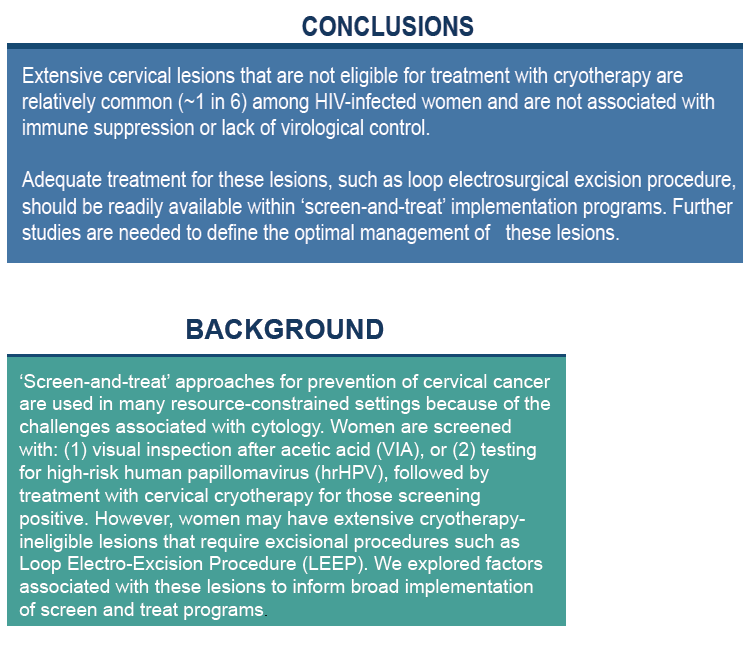
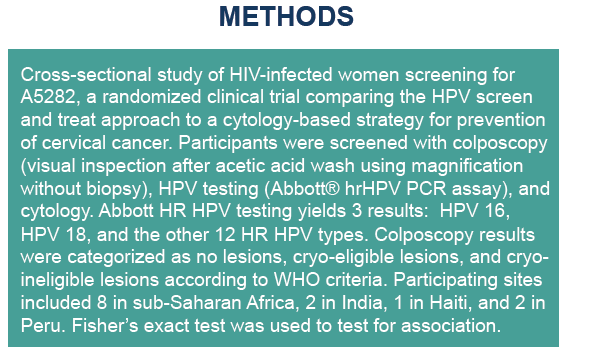
program abstract
Background: 'Screen-and-treat' approaches for prevention of cervical cancer are used in many resource-constrained settings because of the challenges associated with cytology. Women are screened with: (1) visual inspection after acetic acid (VIA), or (2) testing for high-risk human papillomavirus (hrHPV), followed by treatment with cervical cryotherapy for those screening positive. However, women may have extensive cryotherapy-ineligible lesions that require excisional procedures. We explored factors associated with these lesions to inform broad implementation of screen and treat programs.
Methods: Cross-sectional study of HIV-infected women screening for A5282, a randomized clinical trial comparing the HPV screen and treat approach to a cytology-based strategy for prevention of cervical cancer. Participants were screened with colposcopy (visual inspection after acetic acid wash using magnification without biopsy), HPV testing (Abbott® hrHPV PCR assay), and cytology. Colposcopy results were categorized as no lesions, cryo-eligible lesions, and cryo-ineligible lesions according to WHO criteria. Participating sites included 8 in sub-Saharan Africa, 2 in India, 1 in Haiti, and 1 in Peru. Fisher's exact test was used to test for association.
Results: 907 women who screened for A5282 had complete colposcopy, hrHPV, and cytology results. The median age (years) was 37 [IQR 32, 42]; median CD4 (cells/mm3) was 524 [IQR 386, 712]; 70% has plasma HIV-1 RNA PP=0.024).
Conclusions: Extensive cervical lesions that are not eligible for treatment with cryotherapy are relatively common (~1 in 6) among HIV-infected women and are not associated with immune suppression or lack of virological control. Adequate treatment for these lesions, such as loop electrosurgical excision procedure, should be readily available within 'screen-and-treat' implementation programs. Further studies are needed to define the optimal management of these lesions.
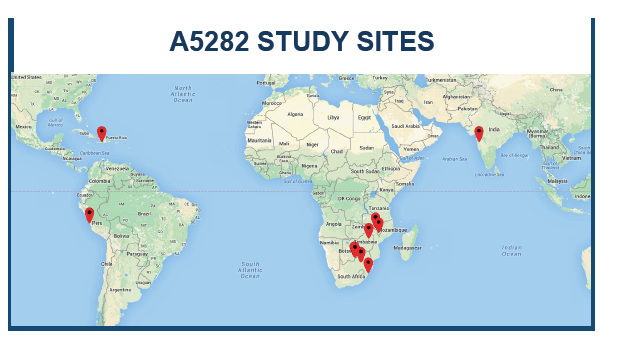
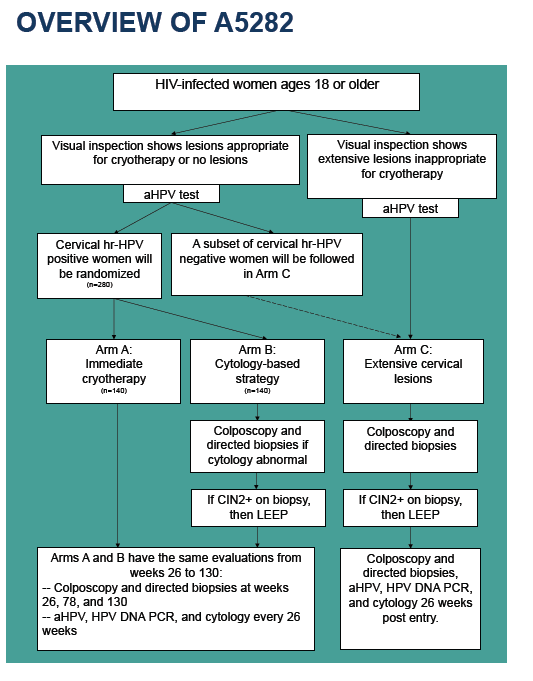
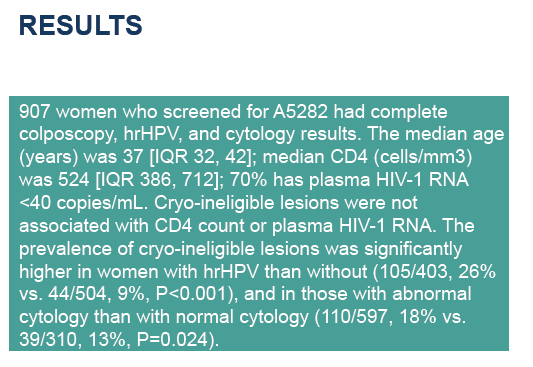
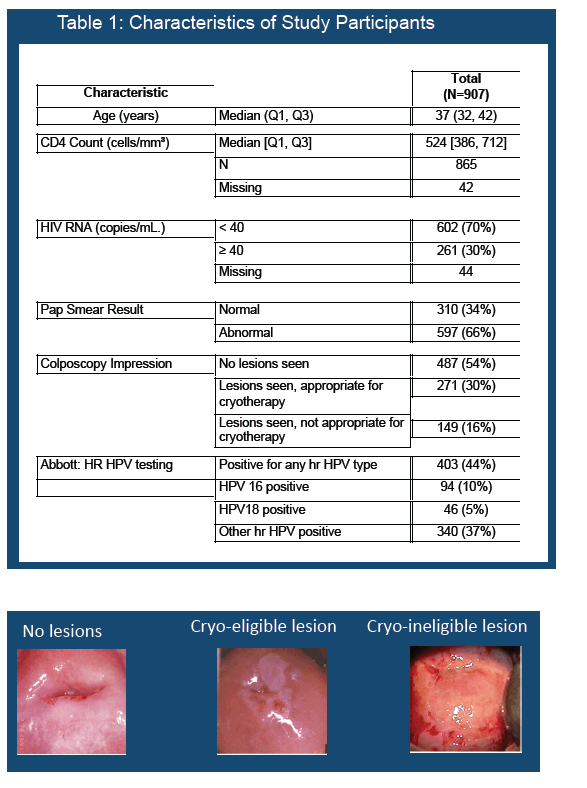
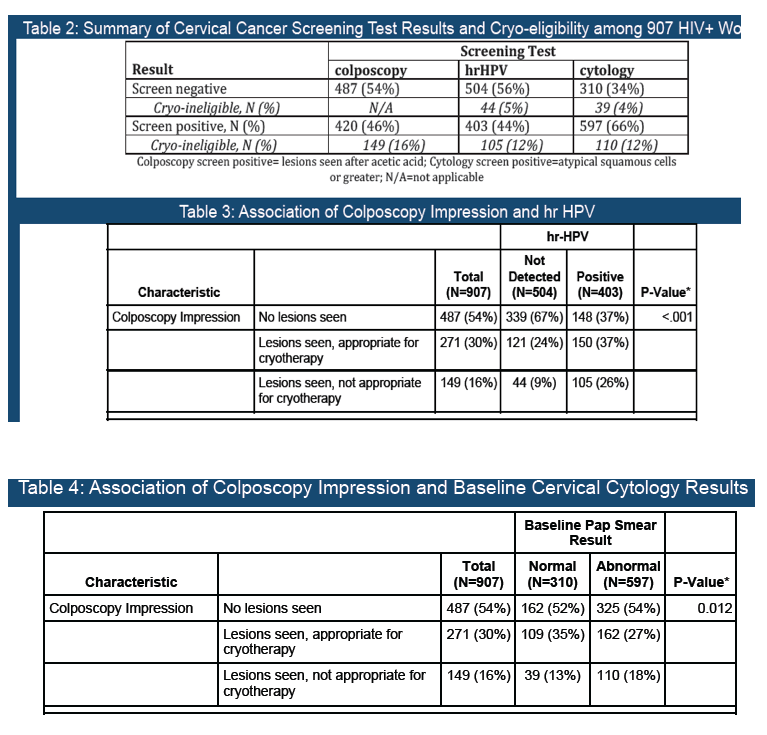
|
|
| |
| |
|
|
|